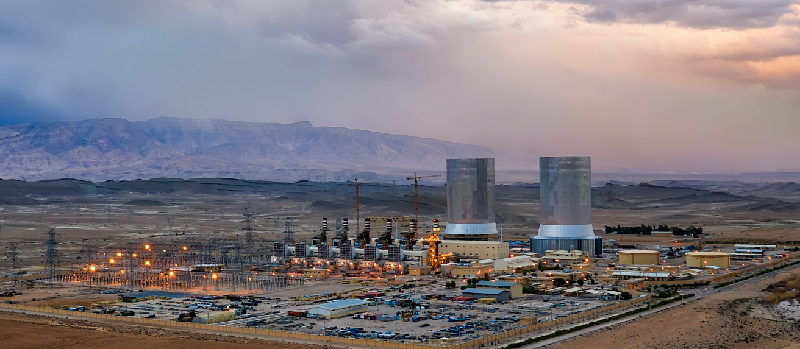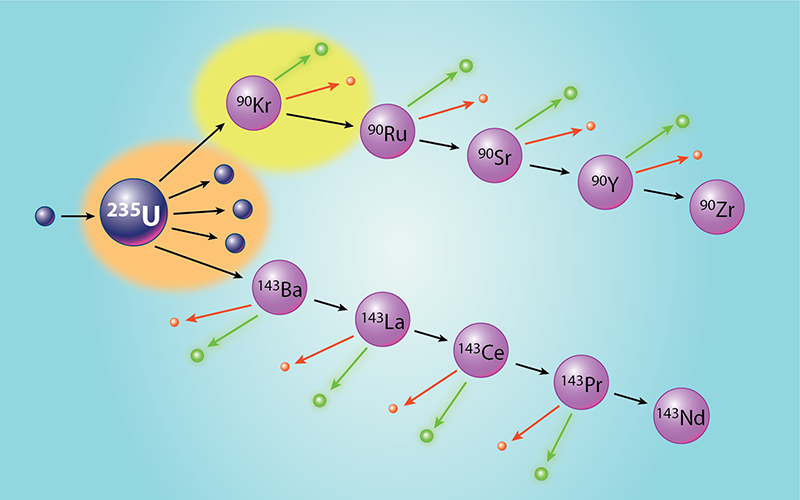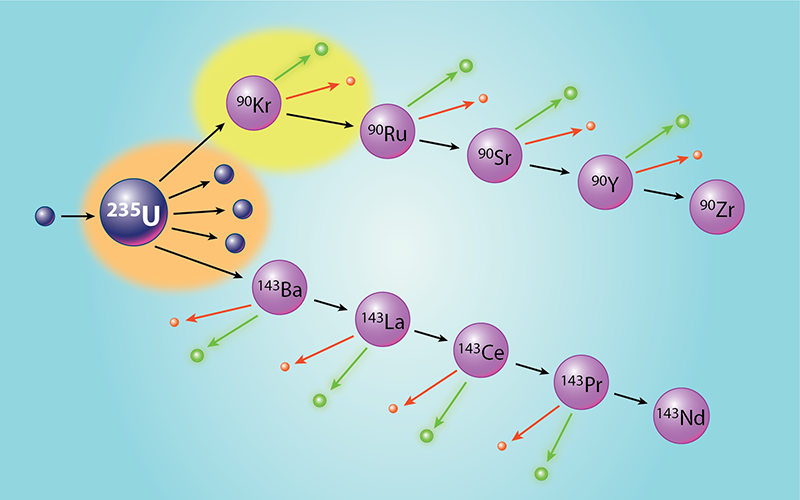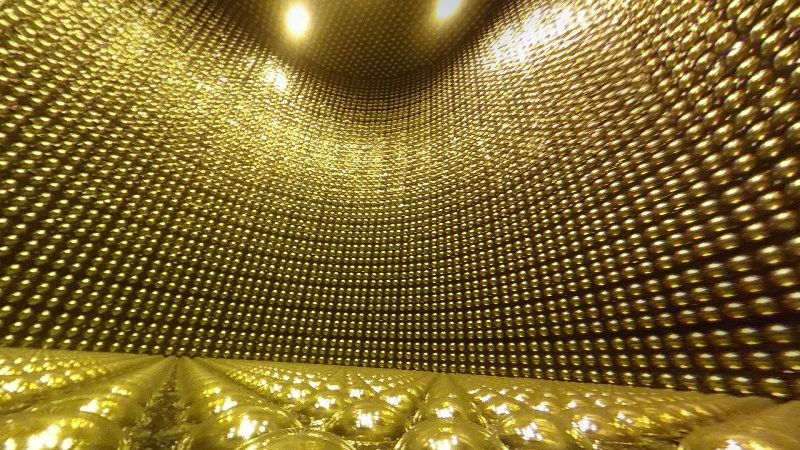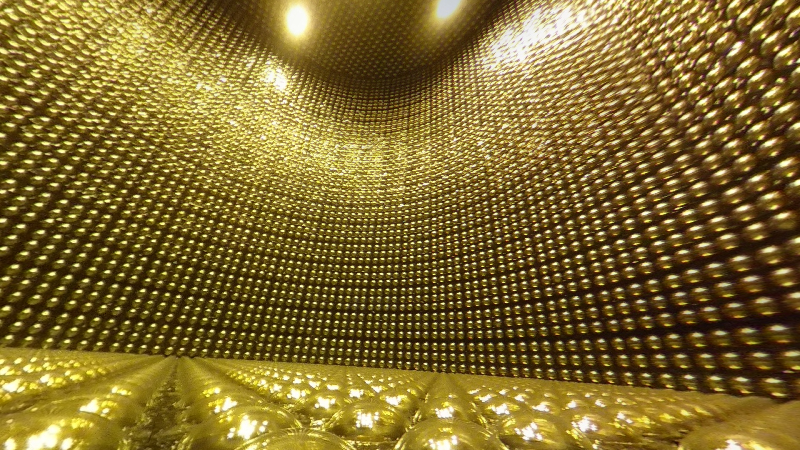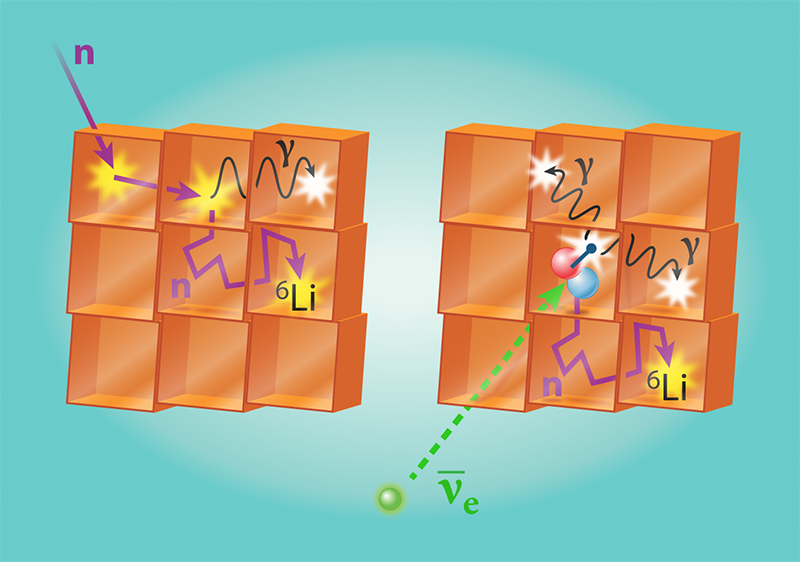Neutrino Detectors for National Security
Nuclear reactors pose a dilemma. They provide carbon-free power and currently generate 14% of the world’s electricity, but many also produce plutonium, an essential component of some nuclear bombs. Physicists have recently demonstrated neutrino detectors that can continuously watch for the removal of plutonium, and a paper published today in Reviews of Modern Physics (RMP) outlines the state of play for the technology, including its limitations [1].
“Neutrinos are never the easiest solution to a problem,” says Patrick Huber, a physicist at Virginia Tech in Blacksburg, who has spent his career studying the particles and who coauthored the paper in RMP [1]. “You would only use them in a context where other solutions don’t work.” But there are countries, like Iran and North Korea, where the options for monitoring are limited.
Nuclear reactors produce a slew of neutrinos (actually antineutrinos, but the distinction only matters when discussing the details of nuclear reactions). While working on fundamental physics experiments over the last two decades, physicists have also been developing the theory and technology needed to make neutrino detectors that can monitor reactors. Now that these systems exist, there are practical challenges to their use. For example, the current generation of detectors, nearly all of which weigh upwards of a ton, have to be placed within tens of meters of a reactor’s core—inside a facility’s fence.
The cost of these detectors also presents a significant implementation barrier, since building and operating even one detector could potentially require a large fraction of the annual nuclear verification budget (about $170 million) of the International Atomic Energy Agency (IAEA), the organization that audits nuclear reactors. So the IAEA has no immediate plans to use the technology. But researchers are still hopeful that the technology will find use. “This kind of monitoring is eminently feasible. We have already done it and could do it at other reactors fairly easily,” says Bryce Littlejohn, a nuclear physicist at the Illinois Institute of Technology in Chicago.
Real-Time Safeguards
Accounting for plutonium currently requires turning off a reactor and then performing a chemical analysis on each of its fuel rods, which number in the tens of thousands for a commercial reactor. The analysis is straightforward but “cumbersome and very dangerous,” Huber says. “This stuff is so radioactive that you would need to hide behind two meters of concrete to do this.” So instead, commercial reactor inspectors place tags on spent fuel storage containers and seals around reactor cores. The tags are used to earmark spent fuel for an easy tally, and the seals safeguard against a core being opened when a reactor is turned off, for example. Security cameras also monitor the spent fuel.
These methods work as long as inspectors retain access to a facility, and there are no technical issues, such as a camera failing. If there is such a security problem, someone could surreptitiously remove spent fuel rods for nefarious purposes and replace them with fresh rods, Huber says.
The selling point of neutrino detectors is their ability to continuously monitor a reactor’s power production—which depends on the number of rods in its core—and its amount of plutonium. “Real-time measurements are a new capability afforded by antineutrino detectors,” says Bethany Goldblum, a nuclear engineer at the University of California, Berkley, and the founder and director of the institution’s Nuclear Policy Working Group.
Counting Antineutrinos
Neutrino detectors record the number and energy of a reactor’s antineutrinos, which are produced as a byproduct of fission. The fission of a uranium-235 nucleus typically leads to the emission of six antineutrinos as the fission products decay. Fuel rods also contain uranium-238, which can absorb a neutron and become plutonium-239, a nucleus that releases four antineutrinos as it decays.
The detectors register antineutrinos using hydrogen-containing substances, such as water, detergent, or plastic, that are loaded with semi-rare metal ions, such as those of lithium or gadolinium. When an antineutrino collides with a proton (hydrogen nucleus), the proton converts to a neutron and a positron. The detector “counts” this collision if it picks up two signals closely spaced in time. The first is from a pair of gamma rays, which are emitted when the positron annihilates with an electron; the second comes from the two fragments generated when a metal ion is split apart by capturing the neutron.
The number of antineutrinos depends on the number of fission events in the reactor and is directly related to the power the reactor produces. The energies of the particles tell you what kind of nuclei are fissioning. Over time, as uranium converts to plutonium, the average energy of the antineutrinos decreases in a predictable way, which allows researchers to track the amounts of each component of the fuel rods.
Nobel Prize, Not World Peace
While helping to reduce nuclear proliferation is important to physicists, improving physics theories is what initially spurred neutrino detector development. The first detectors were built to measure fundamental properties of neutrinos, such as so-called neutrino oscillation (see Focus: Nobel Prize—Neutrinos Oscillate). Later experiments uncovered a difference between the predicted and the measured antineutrino flux from a nuclear reactor. Finding the source of this discrepancy—a problem still unsolved—sparked interest in the field, as it potentially involves a new particle, Huber says. “Discovering a new particle is the career dream of every experimental particle physicist.” Developing the knowledge required to make detectors for nuclear security is a happy byproduct of that search, he adds.
Making these detectors also required engineering advances. Classic neutrino detectors are built around enormous tanks of liquid that are thousands of meters underground, with the overlying rock needed to shield out cosmic rays. The Super-Kamiokande detector in Japan, for example, is 1000 meters below ground and includes a tank containing 50 kilotons of water. But for nuclear security, the detector needs to be close to the source and to be mobile in order to travel between reactor sites.
Researchers recently solved these problems, demonstrating above-ground, mobile detectors that can accurately measure neutrinos at commercial reactors. The detectors work by recording the flashes of visible light (scintillation events) produced when a neutrino interacts with the detection medium (the scintillator). To make the detectors operational above ground, researchers used new scintillators and split them up into tubes or cubes, a process called segmenting. Segmentation makes reactor neutrino scintillation events distinguishable from those from sources that underground facilities never had to worry about, such as fast neutrons produced by cosmic rays. When a particle enters, the pattern of segments that light up indicates the particle’s identity.
The recently demonstrated detectors included VIDARR (1 ton), from Liverpool University, UK; PROSPECT (4 tons), based at Oak Ridge National Laboratory (ORNL), Tennessee; and the small-scale prototype detector CHANDLER (80 kg), from Virginia Tech. Each has detected neutrinos from a nuclear power plant, and each fits inside a trailer or shipping container. PROSPECT also demonstrated the high-precision energy spectrum measurements required to make an above-ground estimate of a reactor’s plutonium content.
Practical Limitations and a Hefty Price Tag
But the technology has challenges, the most significant of which is the requirement to be close to a reactor. Neutrinos easily pass through a reactor’s walls because they rarely interact with matter, but this property also leads to very few detections, says Nathaniel Bowden of Lawrence Livermore National Laboratory, California, co-spokesperson of the PROSPECT team. For example, at a distance of 9 m, PROSPECT picked up about 700 antineutrinos of the roughly 1019emitted per day by the High Flux Isotope reactor at ORNL. This low rate, however, is still sufficient for detectors like PROSPECT to make meaningful measurements.
The distance limitation is a real issue, says Alex Glaser, who studies policy questions related to nuclear nonproliferation at Princeton University, New Jersey. Detecting undeclared facilities, rather than monitoring known ones, is the “holy grail,” and neutrino detectors don’t currently have that capability, he says. Physicists are building a neutrino detector called WATCHMAN that aims to spot a clandestine reactor in the shadow of a known facility from a distance of 26 km. But even at that distance, the detector must still be located within the country being monitored. Detectors that operate from further afield, for example, outside of a country’s borders, “would be a game changer but remain elusive for now,” Glaser says.
Calculations carried out by Huber and his colleagues indicate that a neutrino detector would need over 300 kilotons of scintillator to discern a reactor 1000 km away [1]. Even with that size, it would only detect three neutrinos per year. And then there are background signals from other reactors around the globe. A neutrino detector at Iran’s border, for example, could be within 1000 km of an undeclared reactor, but it would also sit 5000 km from Europe’s 400 gigawatts’ worth of nuclear power. “The neutrinos from those [European] reactors are going to drown out the Iranian ones,” Huber says.
Cost also poses a problem. A 4-ton detector, such as PROSPECT, costs around $5 million, while the price tag on a 40-ton detector is $100 million. A 300-kiloton scintillator could easily require an outlay approaching a billion dollars, says Rachel Carr, a nuclear physicist at the Massachusetts Institute of Technology, Cambridge. It’s unclear who would pay for this upfront capital cost, she says, but new regulations could be adopted that would require host countries to foot the bill. Glaser notes that building a detector is just one part of the budget—there are personnel costs for operating the device and analyzing the data. Factor in that there are 450 reactors in 30 countries, and the costs could quickly become unmanageable, he says.
Beyond a Nuclear Security Tool
Despite these limitations, researchers are confident that the technology will find use as a nuclear safeguard. Making that step will require both finding the right scenario and updating current nuclear safeguarding protocols, which Goldblum sees as the biggest hurdle. “We have the capability right now to build a full-scale mobile system,” she says. For such a detector to be adopted “really comes down to the IAEA seeing value in the system and then the host country accepting this kind of monitoring.”
Those hurdles, Huber thinks, could be overcome for countries such as North Korea, where there is a lack of trust, and the stakes are high. “In this context, the cost of a detector wouldn’t be prohibitive,” he says. Glaser agrees. If concerns arise that the IAEA might be denied access to a reactor, then “a neutrino detector could suddenly become this magic piece of equipment that does something important,” he says. But not everyone is convinced that those conditions would warrant a detector’s hefty price tag.
“The cost of [building] many detectors is just so high that it’s not practical within a real-world context,” Carr says. Carr thinks implementation of these detectors will only happen if they find a role beyond that of a monitoring tool. “If [physicists] can come up with some value added, like the ability to reemploy weapons scientists, that maybe makes neutrino detectors a bit more practical,” she says. Giving scientists at North Korean nuclear facilities a tool to probe neutrino oscillations could shift their focus from weapons development to scientific discovery and also provide a connection to the scientific community. “It’s a stretch,” she says. But such a scenario could be more likely if the North Korean political situation improves.
Jonathon Coleman, a nuclear physicist at Liverpool University, UK, who helped build VIDARR, is more positive about the tool’s uptake, envisioning a future where neutrino detectors are stationed at every reactor around the world. And Littlejohn, who was involved in PROSPECT, thinks that the devices could find use at new reactors that are cooled with opaque liquids such as molten sodium, rather than water. These liquids block a security camera’s view of the fuel rods. Traditional temperature sensors and flow meters—used to measure reactor power—have the problem that their metal components quickly corrode. “You either have to create brand new monitors that work in liquid sodium, or you could use an antineutrino detector,” Littlejohn says. “It doesn’t need to be a tool exclusively for nuclear security.”
–Katherine Wright
Katherine Wright is a Senior Editor for Physics.
Correction (16 March 2020): The article was corrected to clarify the details of the process by which antineutrinos are detected. The figure illustrating the detection was also updated.
References
- A. Bernstein et al., “Colloquium: Neutrino detectors as tools for nuclear security,” Rev. Mod. Phys. 92, 011003 (2020).





